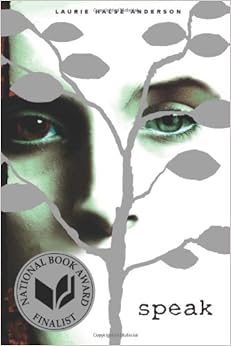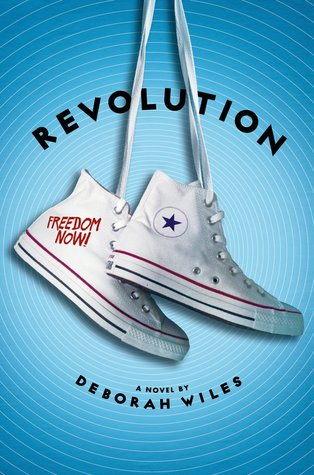One of the things I love about the world of children’s writing is how passionate people are about their opinions and how excited most of us are to engage in lively, thoughtful discussions of craft. One of those conversations got started this week when a blogger at School Library Journal said this:
“While present tense will probably have no bearing on whether a book receives Newbery consideration, it is nevertheless bad writing, and 90% of the writers who use it can’t pull it off.” ~Jonathan Hunt
He went on to list all the no-good, very-bad things about books written in present tense, especially first person present tense.
Now, if you’re not an English teacher or a writer or a particularly detail oriented reader, you probably don’t think about this when you’re reading. Most of us don’t pause mid-chapter to say, “By golly…this is first person present tense narration!” In fact, if the story is written well, we usually don’t notice at all. If you’re not the sort of person who pays attention to such things, here’s a quick overview.
First person means a character in the story is telling the story, either in past or present tense.
1st person past: I leaned over to pet the dolphin, and it chomped down on my hand.* 1st person present: I lean over to pet the dolphin, and it chomps down on my hand.Third person means an outside narrator is telling the story. So…
3rd person past: She leaned over to pet the dolphin, and it chomped down on her hand. 3rd person present: She leans over to pet the dolphin, and it chomps down on her hand. *Yes, this happened. It was a lapse in judgement.
*Yes, this happened. It was a lapse in judgement. Anyway… there’s also the question of whether third person narration is omniscient (with a sort of eye-in-the-sky storyteller, who knows everything and can see inside all the characters’ heads) or limited (where the story is in third person but you still experience it from a particular character’s point of view & don’t know what the others are thinking). And there’s also second person, but those are topics for another day.
Authors have lots of different reasons for choosing the narrative voice for a particular book. One story might work best in third person past tense, with an omniscient narrator, while another might be better told in first person. I tend to agree with Mr. Hunt that first person present tense, done poorly, can be particularly grating to a reader’s sensibilities. But I also think it can be a powerful narrative voice in the hands of a talented writer. Here are just a few examples, some of which you’ve probably seen on awards and bestseller lists.










I asked Facebook friends to share some thoughts on first person, present tense point of view, and I think their responses offer a great, diverse, and thoughtful perspective on this topic.
When does first person present tense work well, and why might an author choose it? And what are some of your favorite books using this narrative voice?
WINTERGIRLS, I think. Everything is so heightened in that book, everything is about life in that exact moment just as the character perceives it. The character herself is really stripped of perspective, stripped of everything besides her present. I also think it’s simply necessary sometimes, in books so much about growth and change–narration that takes place AFTER the moment of realization and change can create some distance between narrator and subject, giving the narrator wisdom the character does not have, and thus depriving the reader of the chance to really experience that change with the reader. There’s so much artistry in first person present–you can use every aspect of the telling of the story to help convey the energy of the character journey.
~Anne Ursu, author of BREADCRUMBS and THE REAL BOY
I had written Chained in the past tense at first, & Patricia Lee Gauch said during a critique at Chautauqua, “Something’s telling me you should write this in the present tense.” I tried it and it felt right, so switched it to a present tense novel. I think it offers a feeling of traveling in real time along with the characters.
~Lynne Kelly Hoenig, author of CHAINED
I often choose first-person because that voice helps me to more effectively make an emotional connection with my reader, and I see that as a vital element of my work.
~Nikki Grimes, author of PLANET MIDDLE SCHOOL and WORDS WITH WINGS
Liar & Spy by Rebecca Stead. It HAS to be in first person present tense or the whole thing would fall apart. There is the story that Georges is telling us — the story he is telling himself — and then there is the whole truth. The story is of him learning/admitting the truth, and told in the past tense it would lose all of its power. Well, not all of it’s power, because Rebecca Stead is amazing.
~Megan Frazer Blakemore, author of THE WATER CASTLE and THE SPYCATCHERS OF MAPLE HILL
HUNGER GAMES. That trilogy would instantly lose half its intensity if it were written in third person, so we weren’t so immediately in Katniss’s head and experiences, or if it were in past tense, which would mean that the action is over and completed and Katniss survived it all to tell it from a place of safety. First person present can be overused for sure, and used badly, but in it, we do not know what’s going to happen to our viewpoint character because s/he doesn’t know him/herself, and if you’re invested in the character, that is close to the highest-tension place you can be as a reader.
~Cheryl Klein, senior editor at Scholastic
In Jessica Spotswood’s excellent Cahill Witch Chronicles (starting with BORN WICKED), the present-tense narration works especially well to help readers experience the narrator’s relationships with her two sisters. If the books were written in past tense, the narrator would have more time to reflect and reconsider her powerful and not always kind reactions, and we’d lose a lot of the emotional intensity and honesty that forms the heart of the story. Additionally, a lot of tension in the series comes from the fact that we know one of the sisters (perhaps the narrator) is going to die, but neither we nor the narrator know which sister it will be. This tension can really only exist in a story told in the present tense.
~Caroline Carlson, author of THE VERY NEARLY HONORABLE LEAGUE OF PIRATES books
I’m currently finishing up a middle-grade present tense book. I think it works in particular circumstances (and I’ve definitely used it before). In this case, the protagonist is stuck in an emergency situation for a period of 48 hours, so the present tense is for her present emergency, but during the crisis, she spends a lot of time in flashbacks. The use of present tense vs. past tense I think really anchors the story and differentiates the two layers, while also allowing me to heighten the urgency of the crisis.
~Karen Rivers, author of THE ENCYCLOPEDIA OF ME
WE WERE LIARS by E. Lockhart. This story told from any other POV would not have had as much of an impact on me. Finding out what happens at the same time as Cadence was heart rending. I was an emotional wreck while reading it, and sad for days after.
~Wendy Watts Scalfaro, teacher-writer
Nora and I just read Lions of Little Rock and The One and Only Ivan. If I recall, both were written in 1st person present. We loved both. We’re not critics of writing ability, but the tense used did not change how we enjoyed the stories. In fact, it wasn’t until I read your post that I even considered what tense the authors used.
~Art Graves, bookseller & dad
It’s often used in verse, and may particularly help explore layers of time when the subject is history. I agree with others re the sense of immediacy, which may be partly why Jacqueline Woodson chose it for brown girl dreaming and Marilyn Nelson for Carver and how i discovered poetry, inviting readers to be part of a particular time, looking back and ahead.
~Jeannine Atkins, author of BORROWED NAMES:POEMS ABOUT LAURA INGALLS WILDER, MADAM C.J. WALKER, MARIE CURIE, AND THEIR DAUGHTERS
I used it in Trauma Queen, which is about a tween girl’s terror of being mortified, at any given moment, by her performance artist mom. The first person present tense helped me convey a “Oh no–what will she do next?” urgency. I think it helped put the reader in my protagonist’s (often uncomfortable) shoes.
~Barbara Dee, author of TRAUMA QUEEN
I chose first person present tense for THE BALLAD OF JESSIE PEARL because it felt right for this particular book. My novel is set in the 1920’s and about a subject that modern American kids would know little about: tuberculosis. My hope is that by making the choices that I did, it pulls the reader in close and the immediacy erases the nearly one hundred year time gap from 1922 until today.
~Shannon Hitchcock, author of THE BALLAD OF JESSIE PEARL
We used it in the Sugar Plum Ballerina chapter books. I think it gives the books an immediacy that helps hook younger readers. As Barbara Dee said above, it seems to me to increase urgency.
~Deborah Underwood, author of THE QUIET BOOK and HERE COMES THE EASTER CAT
My first two novels were in first/present and my next ones are in first/past. For my first book, Rules, present tense is just the way the words came. I didn’t even think about it. Kids often say about Rules that they felt like they were there with Catherine experiencing the story, not reading it. Both tenses have pluses and minuses, though. It’s more awkward to deal with the passage of time in present, since everything is “now.” Past can have more of a storytelling feel, but that also adds some distance. Readers do have preferences, but that doesn’t mean other choices aren’t valid. There are many ways to tell a story.
~Cynthia Lord, author of RULES, TOUCH BLUE, and HALF A CHANCE
I’m ending this post with Cindy’s comment because I love her last line.
There are many ways to tell a story.
I am always wary of writing advice presented in black and white terms. Stories are more complicated than that, and writing them requires a spirit of openness and exploration. Good writers – whether they’re students or professionals – have always made choices about narrative voice thoughtfully, based on story, characters, and craft. No one’s personal preference presented as fact on a blog post should change that.
For more on craft and narrative voice, you should also check out Linda Urban’s brilliant blog post about points of view. It’s another thoughtful exploration of how and why an author makes that decision about voice.
Feel free to continue the conversation in comments – respectful, thoughtful discourse is always welcome here.





Thanks so much for taking the time to explain all this. I think I will share it with the middle school teachers so they can think this through with their readers and writers.
I\’m guessing 90% of the writers who try past tense couldn\’t pull it off to Jonathan Hunt\’s satisfaction, either.
The longer I teach, the more averse I am to hard and fast rules. Even academic writing was once chained to third person tense but now often welcomes first person. Thanks to all the authors who responded; my students will benefit from these insights.
I started to leave a very unkind comment about Heavy Medal here on this post. Thankfully, my copy of 365 Days of Wonder is next to my computer. Choose Kind, Mr. Sharp. Choose Kind.
Thanks for your thoughtful response. I find hard and fast rules unhelpful, but Mr. Hunt is by no means unusual in preferring 3rd person narrative. I’ve noticed in my own work that 1st person present is the perfect tense to show off a strong and distinctive character voice. Unfortunately if the voice is less than spectacular it tends to pale in comparison to the excellent examples you’ve shown in your post. But a less distinctive voice goes over better in past tense and 3rd person where character voice is more evenly balanced with plot and setting.
But as you say each story has its own needs. I’m happy to find a variety of voices and tenses in my reading. How dull if they were all the same!